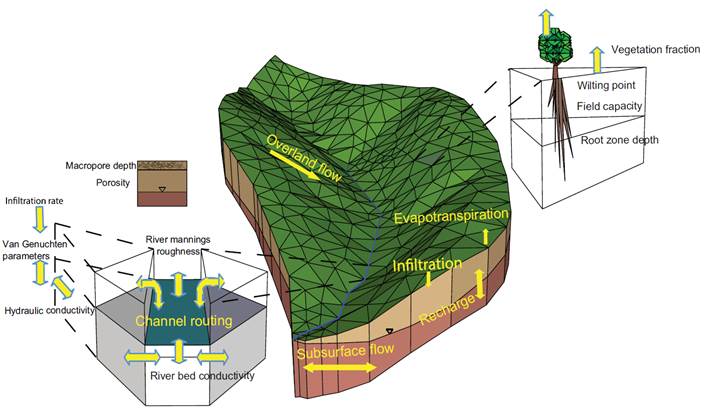Key science findings
- Identification of processes that control droughts and low flows at the catchment scale by using the physically-based model PIHM as a laboratory.
- Enhanced process representation in simpler (larger-scale) models.
Introduction
NERC’s MaRIUS (Managing the Risks, Impacts and Uncertainties of drought and water Scarcity) project explores how best to manage future droughts in the UK. Work package B2 performs detailed modelling of drought processes at the catchment scale using the Penn State Integrated Hydrologic Model (PIHM). It is a fully coupled multi-process hydrologic model with a flexible TIN (triangular irregular network) and linear element structure, allowing for more realistic representation of line features such as the stream network. The detailed coupling of groundwater to the stream enables a more realistic representation of low flow processes, when abstractions are most critical. The work package seek to explore:
- The degree of process coupling (e.g. aquifer to river) needed to represent low flow conditions
- The representation of spatial heterogeneity in a parsimonious way (e.g. of soil moisture and recharge)
- The presence of longer flow paths that would delay the propagation of drought signals in the Thames basin (and how they can be modelled)
- The value of up-scaling a complex physically based model (i.e. using a coarse decomposition of the model domain), compared with running a much simpler conceptual model at larger scales
Research methods
The PIHM model (Modified from Yu et al., (2013), Parameterization for distributed watershed modeling using national data and evolutionary algorithm. Computers & Geosciences 58:80-90. The PIHM model (Modified from Yu et al., (2013), Parameterization for distributed watershed modeling using national data and evolutionary algorithm. Computers & Geosciences 58:80-90. The physically-based, distributed, and integrated model PIHM has been set up for the Kennet catchment, which is part of the Thames basin. It is being used as a laboratory to investigate the relevance of different processes during different prevailing conditions, e.g., wet and dry; summer and winter, etc.
Signatures have been identified that represent the physiographic properties of a catchment. Global sensitivity analysis techniques are used to assess the importance of different parameters (hence the processes they represent), hence the critical parametrisations in the simpler models.

Identification of control processes on low flows
By applying sensitivity analysis techniques on large ensembles of different parameter combinations, the response of model output to perturbations in the parameter fields can be assessed and the relevant processes identified. The robustness of the results can be tested by forcing the model (PIHM) with different drought scenarios.
A platform that assesses the sensitivity of the system to different human activity scenarios will also be developed.
Improved process representation in nation-scale models
The level of process complexity in the large-scale models will be assessed. With the control processes known, the representation in large-scale models will be enhanced by either increasing or reducing the complexity.





